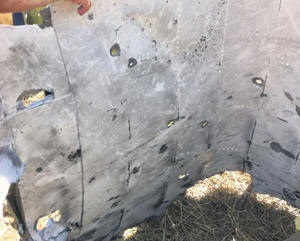 |
|
|
|
|
|
|
|
|
The Dutch Safety Board has established the cause of the
crash on the basis of several sources. For example, the
weapon system used was identified on the basis of, among
other things, the damage pattern on the wreckage, the
fragments found in the wreckage and in the bodies of
crew members, and the way in which the aircraft broke
up.
No
scenario other than a Buk surface-to-air missile can
explain this combination of facts. The
320-square-kilometre area from which the missile was
launched has been determined on the basis of various
simulations. Additional forensic investigation will be
needed to establish the exact launching location;
however, such an investigation lies outside the scope of
the Dutch Safety Board’s mandate.
On
July 17, 2014 an armed conflict was taking place in the
eastern part of
Flying over conflict areas - The Dutch Safety Board has
noticed that the current system of responsibilities with
respect to flying over conflict areas is inadequate.
Operators assume that unrestricted airspaces are safe.
When assessing the risk, the operators do usually take
into account the safety of departure and arrival
locations, but not the safety of the countries they fly
over.
When flying over a conflict area, an additional risk
assessment is necessary. Therefore, the Dutch Safety
Board considers it extremely important that parties
involved in aviation – including states, international
organizations such as ICAO and IATA, and operators –
exchange more information about conflict areas and
potential threats to civil aviation. When processing and
interpreting this information, more attention should be
paid to the development of the conflict, including any
increase of military activity and shootings from the
ground. States involved in an armed conflict should
receive more incentives and better support to safeguard
the safety of their airspace. In addition, the Dutch
Safety Board is of the opinion that operators should
give public account for their flight routes.
Passenger information - After the crash of flight MH17
was reported, many relatives gathered at Amsterdam
Airport Schiphol , hoping to obtain more information
there. At the end of the evening an initial passenger
list was made public. It then took two to four days
before all of the surviving relatives received
confirmation from the Dutch authorities. When gathering
information related to the passenger list and
determining the identity of the occupants and their
surviving relatives, the information that various
parties gathered about the victims and their relatives
was not combined.
The Dutch crisis organization failed to function
properly and the government authorities involved lacked
direction. In order to improve information provision
after a crash, the Dutch Safety Board recommends – among
other things – that passengers’ nationalities be
registered on passenger lists. The Dutch Safety Board
also recommends that the Dutch government make
provisions to improve direction in case of a disaster
abroad with a large number of Dutch victims. Reconstruction - Over the past months, a reconstruction of the forward part of the airplane was assembled at the Dutch air base of Gilze-Rijen. The reconstruction clearly shows the effects of the impact and subsequent blast, and has been important for verification and additional substantiation of the investigation’s results. |
||||
|
|
||||

